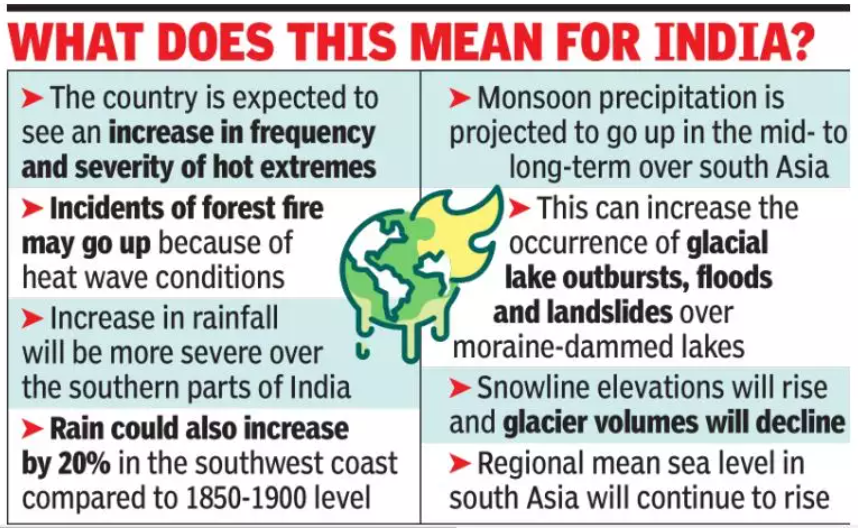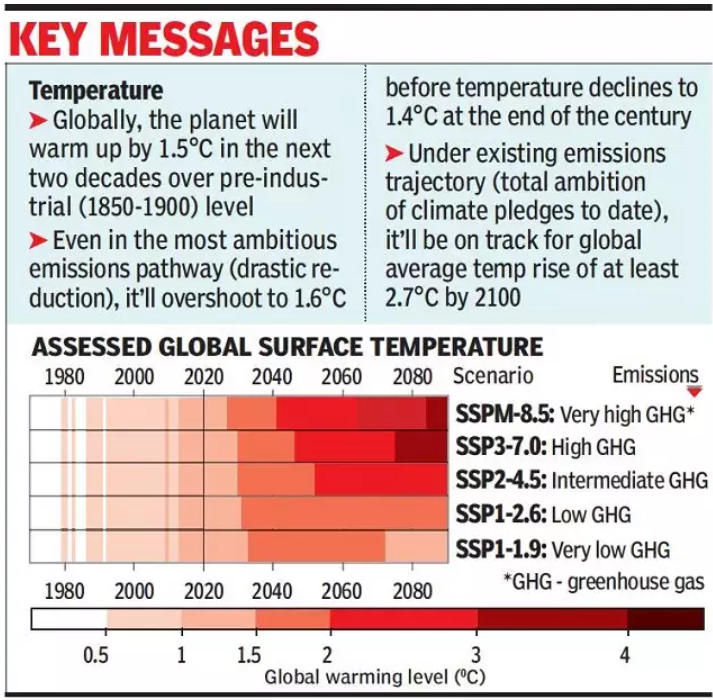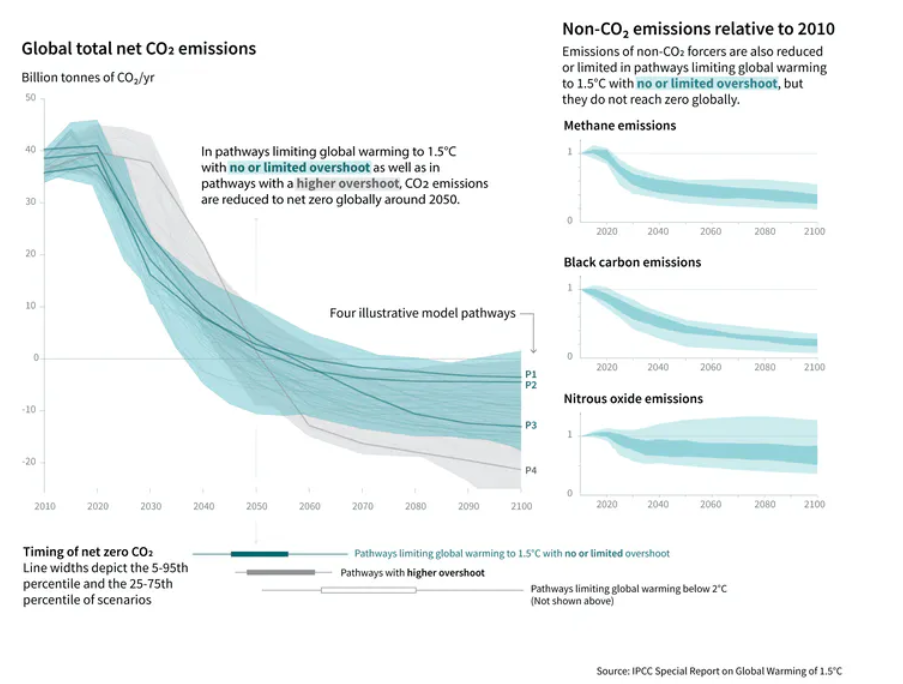ForumIAS announcing GS Foundation Program for UPSC CSE 2025-26 from 19 April. Click Here for more information.
ForumIAS Answer Writing Focus Group (AWFG) for Mains 2024 commencing from 24th June 2024. The Entrance Test for the program will be held on 28th April 2024 at 9 AM. To know more about the program visit: https://forumias.com/blog/awfg2024
Contents
Introduction
The Intergovernmental Panel on Climate Change (IPCC) has released its Sixth Assessment Report, titled “Climate Change 2021: The Physical Science Basis”. The report states that human activities are causing climate change, and the planet is irrevocably headed towards warming by 1.5 degrees Celsius over pre-industrial times in the next two decades.
The report predicts that based on existing commitments by countries to curb their emission, the world is on track for global temperature warming by at least 2.7°C by 2100, calling it ‘Code red for humanity’.
The report also mentions that unless extremely deep emission cuts are undertaken by all countries immediately, the 2015 Paris Agreement goals are unlikely to be met. The report recommended that countries should strive to achieve net-zero emissions — no additional greenhouse gases are emitted — by 2050.
About the IPCC and their reports
The Intergovernmental Panel on Climate Change (IPCC) produces assessment reports that are the most comprehensive scientific evaluations of the state of the earth’s climate.
So far, 5 assessment reports have been produced, the first one was released in 1990. The 5th assessment report was released in 2014, in the run-up to the climate change conference in Paris.
IPCC was set up in 1988 by the World Meteorological Organisation (WMO) and the UN Environment Programme (UNEP). The IPCC does not itself engage in scientific research. Instead, it asks scientists from around the world to go through all the relevant scientific literature related to climate change and draw up logical conclusions.
The IPCC reports are created by three working groups of scientists.
| Working Group | Concerned climate research |
| Working Group-I | Deals with the scientific basis for climate change |
| Working Group-II | Deals with the likely impacts, vulnerabilities, and adaptation issues |
| Working Group-III | Deals with actions that can be taken to combat climate change. |
About the IPCC’s Sixth Assessment Report

The first part (Working Group I) of IPCC’s Sixth Assessment Report release follows a two-week-long plenary session held virtually from July 26 to August 6, 2021. The two remaining parts would be released next year.
The report updates the scientific consensus and charts the future state of the climate since the 5th Assessment Report of 2014.
The latest scientific assessment will influence discussions on the Conference of Parties meeting in Glasgow later this year when countries are expected to announce plans and steps they have taken to curb emissions.
Key findings of the IPCC’s Sixth Assessment Report
The report justifies India’s position that historical cumulative emissions are the source of the climate crisis that the World faces today. Climate change is described by many as a far greater threat to humanity than COVID-19, because of its irreversible impacts.
Global temperature has already risen by about 1.1 degrees Celsius from pre-industrial times and warn that the 1.5-degree-Celsius threshold was likely to be breached before 2040. The 2°C warming is likely to get exceeded by the end of this century. To limit that, the global emissions must peak by 2025 to keep warming at 1.5°C. But that is unlikely to occur.
This is the first time that the IPCC has said that the 1.5 degrees warming was inevitable, even in the best-case scenario.
The report mentions that more intense and frequent heat waves, increased incidents of extreme rainfall, dangerous rise in sea levels, prolonged droughts, melting glaciers will occur all over the world.
The report mentions that the benefits of immediate action can begin to show results over time scales of 10 to 20 years.
Tropical Cyclones
The frequency of cyclones has increased by more than 50%.
Tropical cyclones are getting stronger and wetter with the increased global warming. Sea level increase, High sea surface temperature, the presence of surplus moisture in the atmosphere results in intense cyclonic events.
| Read more: Floods in Europe and lessons for India – Explained, Pointwise |
Green House gases and CO2 emissions
Humans have emitted 2,400 billion tonnes of CO2 since the late 1800s. The carbon dioxide concentrations in the atmosphere — at around 416 parts per million — are the highest they have been in 2 million years
Greenhouse-gas emissions from human activity have raised global temperatures by 1.1 degrees Celsius since around 1850.
The concentrations of lethal air pollutants such as sulphur dioxide (SO2), nitrogen dioxide (NO2), ammonia (NH3), ozone (O3) and Particulate Matter2.5 are at their highest in south Asia.
Global warming
Currently, the global mean temperature rise is 1.1°C.
The temperatures during the most recent decade (2011-2020) exceed those of the most recent multi-century warm period, around 6,500 years ago
Sea level rise
Oceans are warming, and sea level is increasing by 3.7 mm, or about 0.1 inches, a year.
Sea-level rise has tripled compared with 1901-1971. The Arctic Sea ice is the lowest it has been in 1,000 years
Rainfall
A phenomenon such as heavy rainfall over land, for instance, could be 10.5% wetter in a world warmer by 1.5°C, and occur 1.5 times more often, compared to the 1850-1900 period.
At a global scale, extreme daily rainfall events would intensify by about 7% for each additional degree Celsius of global warming
Heatwaves
At 2 degrees of global warming, heat extremes would more often reach critical tolerance thresholds for agriculture and human health.
Snow
There has been a 40 percent decrease in Arctic sea ice since 1979.
Snow-covered areas and snow volumes will decrease during the 21st century, snowline elevations will rise and glacier mass is likely to decline with greater mass loss in higher greenhouse gas emission scenarios.
Rising temperatures and precipitation can increase the occurrence of glacial lake outburst floods and landslides over moraine-dammed lakes.
Mountain glaciers will continue to shrink and permafrost to thaw in all regions where they are present.
Large Volcanic events
Before the end of the century, there will be at least one large volcanic eruption. Large volcanic eruptions shoot out aerosols (small particles) into the upper atmosphere. These reflect sunlight and induce a long-term cooling effect on the surface
The compound of extreme events
The report mentions that two or more climate change-induced events are happening back to back, triggering each other, or occurring simultaneously. Concurrent heat waves and droughts are likely to become more frequent.
For example, a recent event in Uttarakhand, involving heavy rainfall, landslides, snow avalanche, and flooding, is a good example of a compound event.
Other findings
- If emissions continue to rise, oceans and land, two important sinks would be greatly weakened in their ability to absorb atmospheric carbon dioxide.
- Marine heatwaves are causing coral bleaching and greater acidification demolishing fish stocks.
- The last decade was hotter than any period of time in the past 125,000 years.
The report mentions that humanity will continue to see the worst effects impact on lives, livelihoods, and natural habitats.
Key findings of the IPCC’s Sixth Assessment Report on India

- The Indian Ocean is warming at a higher rate than other oceans. As a result, India will face the following issues.
- Changes in monsoon precipitation are expected, with both annual and summer monsoon precipitation projected to increase. More severe rain is expected over southern India in the coming decades. The report says the presence of aerosols and particulate matter due to human activity has influenced rainfall events in the Indian subcontinent.
- With a 7,517-km coastline, India will also witness a rise in sea levels, leading to frequent and severe coastal flooding in low-level areas. Across the six Indian port cities of Chennai, Kochi, Kolkata, Mumbai, Surat, and Visakhapatnam, 28.6 million people would be exposed to coastal flooding if sea levels rise by 50 cm.
- The global mean sea level in the Indian Ocean is rising at 3.7 mm annually. Extreme sea-level events, that previously occurred once every 100 years, will now be seen nearly every year
- Glaciers in the Hindu Kush Himalayan (HKH) region will keep shrinking and the snow cover will retreat to higher altitudes.
- Heatwaves and humid heat stress will be more intense and frequent in the 21st century.
- Northern India or specifically the Indo-Gangetic Plain was one among three large agricultural regions along with the US Midwest and Central Valley, where high ammonia concentrations were seen due to large-scale burning of biomass.
- India’s geography makes it extra vulnerable to extreme climate events. The geography of India is such that it is surrounded by the warm tropical waters of the Indian Ocean on all three sides and the melting Himalayas on the north.
Suggestions of the IPCC’s Sixth Assessment Report
The IPCC report asks nations to follow the science and embrace their responsibility to keep the goal of 1.5C alive.
- The report also suggests, countries come forward with ambitious 2030 emission reduction targets and long-term strategies with a pathway to net-zero.
- The IPCC report also acknowledged that India was already doing much more than it was required to do. But the report demanded India declare net-zero emission targets.
| Read more: Net Zero Emissions Target for India – Explained, Pointwise |
- The developed countries with legacy emissions have to take steps to deep cuts and transfer technology without strings to emerging economies and heavily fund mitigation and adaptation.
- The IPCC report demands that all countries should update their climate action plans, called nationally determined contributions or NDCs with stronger actions.
- There must be no new coal plants built after 2021. Organization for Economic Co-operation and Development (OECD) countries must phase out existing coal by 2030, with all others following suit by 2040.
- By 2030, solar and wind capacity should quadruple and renewable energy investments should triple to maintain a net-zero trajectory by mid-century
- The traditional knowledge of the world’s indigenous peoples can be a vital tool in the fight to mitigate the growing climate crisis. The report cited a number of instances such as,
- Peruvian fishermen’s first thought of the name ‘El Niño’
- The contributions of Inuit communities to community-based monitoring across the Arctic,
- Indigenous Australian knowledge of climatic patterns
- Technologies are available to disrupt the current fossil fuel-driven industrial system. The countries now have to take disruptive actions to disrupt fossil fuels.
- A countrywide assessment that urgently maps the risks based on the changes in climate is much needed.
Conclusion
The mitigation strategies submitted by nations through the Paris Agreement are insufficient to keep the global temperature increase within the 1.5°C or even 2°C limits.
Scientists say a temperature rise beyond 2 degrees Celsius would result in catastrophic and irreversible changes that would make it difficult for human beings and other species to survive.
So, the IPCC’s Sixth Assessment Report requires world leaders, the private sector, and individuals to act together with urgency and do everything it takes to protect our planet.
Terms to know:
Sources:
- The Hindu (Article 1, Article 2, Article 3, Article 4, Article 5)
- The Indian Express (Article 1, Article 2, Article 3, Article 4)
- Livemint (Article 1, Article 2, Article 3)
- Down To Earth (Article 1, Article 2, Article 3, Article 4, Article 5, Article 6, Article 7, Article 8, Article 9, Article 10)
- Times of India (Article 1, Article 2)
- Business Standard







